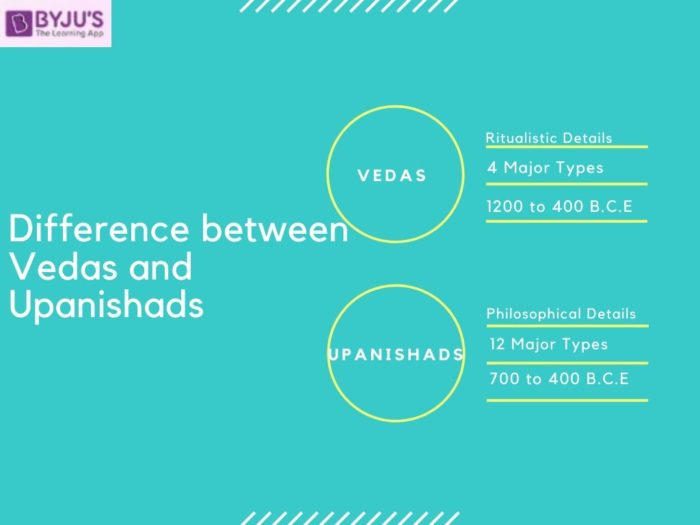Difference between Vedas and Upanishads is explained here in detail.
The Vedas are a large body of religious texts originating in ancient India. Composed in Vedic Sanskrit, the texts constitute the oldest layer of Sanskrit literature and the oldest scriptures of Hinduism.
The Upanishads are late Vedic Sanskrit texts of religious teachings and ideas still revered in Hinduism. The Upanishads played an important role in the development of spiritual ideas in ancient India, marking a transition from Vedic ritualism to new ideas and institutions.
Aspirants would find this article relevant while preparing for the Ancient Indian History Section of the IAS Exam.
Difference between Vedas and Upanishads – UPSC Notes:- Download PDF Here

The major differences between Vedas and Upanishads are:
| Vedas | Upanishads |
| Vedas were composed over a time period ranging from 1200 to 400 B.C.E | The Upanishads were written over a time period ranging from 700 to 400 B.C.E |
| Vedas focused on ritualistic details, uses and traditions. | Upanishads focused on Spiritual enlightenment. |
| Vedas means knowledge in Sanskrit. It is known as “Apauruseya” meaning not of man. | Upanishad is derived from the words upa (near) and shad (to sit). It is derived from the concept of sitting near the feet of the teacher. |
| There are 4 different Vedas – Rigveda, Samaveda, Yajurveda, Atharvaveda. | More than 200 Upanishads have been discovered. Each Upanishad is associated with a certain Veda. There are 14 Upanishads which are most well known or most important – Katha, Kena, Isa, Mundaka, Prasna, Taittiriya, Chhandogya, Brihadaranyaka, Mandukya, Aitareya, Kaushitaki, Svetasvatara and Maitrayani. |
| All the 4 Vedas are compositions of different texts. | Upanishads are in the last section of any Vedas. Upanishads are a subcategory of a Veda. |
| Vedas are subclassified into 4 major text types – Samhitas (Mantras), Aranyakas (Texts on rituals, sacrifices, ceremonies), Brahmanas (it gives explanation of sacred knowledge, it also expounds scientific knowledge of Vedic Period) and the 4th type of text is Upanishads. The 3 types of texts dealt with ritualistic aspects of life. | Upanishads is one among the 4 major text types of Vedas. Upanishads are texts on spiritual knowledge and philosophy. Upanishads originated from each branch of Vedas. Upanishads deals with the philosophical aspects of life |
After learning about the differences between Vedas and Upanishads, visit the below given links to learn more about Different types of Vedas, Vedic Literature, Vedic civilization and other important details. Also refer to the link on Ancient and Medieval Indian History NCERT Notes.
- Types of Vedas – Rigveda, Samaveda, Yajurveda, Atharvaveda
- Rigveda – Major Facts and Importance
- Vedic Literature – Vedas, Brahmanas, Aranyakas, Upanishads
- Vedic Civilization – Early and Later Vedic Period
- Difference between Early Vedic Period and Later Vedic Period
- 16 Mahajanapadas – History, Location, Capital
- 6 Orthodox Schools of Hindu Philosophy
- Philosophy in Medieval India
- NCERT Notes: Ancient Indian History
- NCERT Notes: Medieval Indian History
- Comprehensive List of Difference between Articles – Economics, Polity, History & more
Difference between Vedas and Upanishads – UPSC Notes:- Download PDF Here
FAQ about Vedas and Upanishads
How many Upanishads are related to the four Vedas, and what are they?
Which is the oldest Veda among the four?
For more articles and exam-related preparation materials for UPSC 2022, refer to the links given in the table below:
Related Links
| IAS Salary | Static GK |
| What is DRDO | Srushti Jayant Deshmukh Age |
| Non Banking Financial Institutions | Article 324 of Indian Constitution |
| Special Purpose Vehicle | Ujala Yojana |


Comments